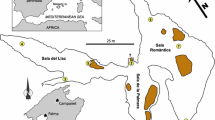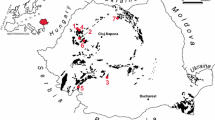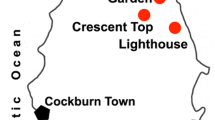Abstract
The radiation dose and environmental health risk of radon concentration in the Lantian karst cave of China to guides and visitors were estimated based on the continuous radon concentration monitoring. Distinct seasonal variations were observed in the radon concentration of the air inside the cave. The maximum concentration occurred in the summer, whereas the minimum radon concentration occurred during the winter. The annual average radon concentration in the caves investigated is slightly higher than the upper bound of radon action level for underground space used in China and less than the upper bound of radon action level recommended by the International Commission on Radiation Protection (ICRP) for workplaces. The annual effective dose to tour guides working in two investigated caves varies from 4.1 to 16.5mSv, depending on different equilibrium factors together with different dose conversion factors proposed in the literature. The annual maximum time that a tour guide or other worker can safely be inside the cave is estimated to be 1,250 or 2,246h, depending on whether one bases this on the high or mean radon concentration, with an equilibrium factor of one in both cases. Given the synergistic effects of smoking, tour guides who are smokers should be in the cave only 10–20% of these hours. In all cases, the annual effective doses to visitors are well below the 1mSv maximum suggested dose for a member of the public for 1 year.






Similar content being viewed by others
References
Al-Shereideh, S. A., Bataina, B. A., & Ershaidat, N. M. (2006). Seasonal variations and depth dependence of soil radon concentration levels in different geological formations in Deir Abu-Said District, Irbid, Jordan. Radiation Measurements, 41, 703–707. doi:10.1016/j.radmeas.2006.03.004.
Ball, T. K., Cameron, D. G., Colman, T. B., & Roberts, P. D. (1991). Behaviour of radon in the geological environment: A review. Quarterly Journal of Engineering Geology, 24, 169–182. doi:10.1144/GSL.QJEG.1991.024.02.01.
Chen, Y., & Li, S. (1995). The discussion on the radioprotection of radon and its decay products of tour karst cave. Guizhou Medical Journal, 19, 251–252 in Chinese.
Copes, R., & Scott, J. (2007). Radon exposure: Can we make a difference? Canadian Medical Association Journal, 177, 1229–1231. doi:10.1503/cmaj.070559.
Cunningham, K. I., & LaRock, E. J. (1991). Recognition of microclimate zones through radon mapping, Lechuguilla cave, Carlsbad Caverns National Park, New Mexico. Health Physics, 61, 493–500. doi:10.1097/00004032-199110000-00004.
Darby, S., Hill, D., Auvinen, A., Barrose-Dios, J. M., Baysson, H., Bochicchio, F., et al. (2005). Radon in homes and risk of lung cancer: collaborative analysis of individual data from 13 European case–control studies. British Medical Journal, 330, 223–228. doi:10.1136/bmj.38308.477650.63.
Denman, A. R., Crockett, R. G. M., Groves-Kirkby, C. J., Phillips, P. S., Gillmore, G. K., & Woolridge, A. C. (2007). The value of seasonal correction factors in assessing the health risk from domestic radon—a case study in Northamptonshire, UK. Environment International, 33, 34–44. doi:10.1016/j.envint.2006.06.021.
Denman, A. R., & Parkinson, S. (1996). Estimates of radiation dose to National Health Service workers in Northamptonshire from raised radon levels: Short communication. The British Journal of Radiology, 69, 72–75.
Dueñas, C., Fernández, M. C., & Cañete, S. (2005). 222Rn concentrations and the radiation exposure levels in the Nerja Cave. Radiation Measurements, 40, 630–632. doi:10.1016/j.radmeas.2005.02.019.
Dueñas, C., Fernández, M. C., Cañete, S., Carreteero, J., & Liger, E. (1999). 222Rn concentrations, natural flow rate and the radiation exposure levels in the Nerja Cave. Atmospheric Environment, 33, 501–510. doi:10.1016/S1352-2310(98)00267-2.
Duffy, J. T., Madden, J. S., Mackin, G. M., McGarry, A. T., & Colgan, P. A. (1996). A reconnaissance survey of radon in show caves in Ireland. Environment International, 22(S1), S415–S423. doi:10.1016/S0160-4120(96)00140-7.
Eheman, C., Carson, B., Rifenburg, J., & Hoffman, D. (1991). Occupational exposure to radon daughters in Mammoth Cave National Park. Health Physics, 60, 831–835.
Furuta, S., Ito, K., & Ishimori, Y. (2002). Measurements of radon around closed uranium mines. Journal of Environmental Radioactivity, 62, 97–114. doi:10.1016/S0265-931X(01)00154-0.
GBZ116—2002 (2003). Standard of People Republic of China: Standard for controlling radon and its progenies in underground space. Beijing: Chinese Standard (in Chinese).
Gillmore, G. K., Phillips, P. S., Denman, A. R., & Gilbertson, D. D. (2002). Radon in the Creswell Crags Permian limestone caves. Journal of Environmental Radioactivity, 62, 165–179. doi:10.1016/S0265-931X(01)00159-X.
Gillmore, G. K., Phillips, P., Denman, A., Sperrin, M., & Pearce, G. (2001). Radon levels in abandoned metalliferous mines, Devon, Southwest England. Ecotoxicology and Environmental Safety, 49, 281–292. doi:10.1006/eesa.2001.2062.
Gillmore, G. K., Sperrin, M., Phillips, P., & Denman, A. (2000). Radon hazards, geology and exposure of cave users: a case study and some theoretical perspectives. Ecotoxicology and Environmental Safety, 46, 279–288. doi:10.1006/eesa.2000.1922.
Hafez, A. F., & Hussein, A. S. (2001). Radon activity concentrations and effective doses in ancient Egyptian tombs of the Valley of the Kings. Applied Radiation and Isotopes, 55, 355–362. doi:10.1016/S0969-8043(01)00065-3.
Health Canada. (2006). Report of the Radon Working Group on a new radon guideline for Canada. Ottawa: Health Canada; Mar. Available at: www.hc-sc.gc.ca/ahc-asc/public-consult/consultations/col/radon/rep-rapp_e.html (accessed 2007 Aug 30).
Hyland, R., & Gunn, J. (1994). International comparison of cave radon concentrations identifying the potential alpha radiation risks to British cave users. Health Physics, 67, 176–179. doi:10.1097/00004032-199408000-00009.
International Agency for Research on Cancer. (2007). France: The Agency. Available at: http://monographs.iarc.fr/ENG/Classification/crthallalph.php (accessed 2007 Oct 4).
International Commission on Radiation Protection (ICRP) (1986). Radiation protection of workers in mines. ICRP publication 47. Oxford: Pergamon.
International Commission on Radiation Protection (ICRP) (1994). Protection against radon-222 at home and at work. ICRP publication 65. Oxford: Pergamon.
Jovanovič, P. (1996). Radon measurements in karst caves in Slovenia. Environment International, 22(S1), S429–S432. doi:10.1016/S0160-4120(96)00142-0.
Jovanovič, P., Kanduč, M., & Kuhar, B. (1992). Dose estimates to Rn-222 concentrations in Postojna cave. Radiation Protection Dosimetry, 45, 191–192.
Kobal, I., Smodiš, B., Burger, J., & Škofljanec, M. (1987). Atmospheric 222Rn in tourist caves of Slovenia, Yugoslavia. Health Physics, 52, 473–479.
Kobal, I., Smodiš, B., & Škofljanec, M. (1986). Radon-222 air concentrations in the Slovenian Karst Caves of Yugoslavia. Health Physics, 50, 830–834.
Krewski, D., Lubin, J. H., Zielinski, J. M., Alavanja, M., Catalan, V. S., Field, R. W., et al. (2005). Residential radon and risk of lung cancer: A combined analysis of 7 North American case–control studies. Epidemiology (Cambridge, Mass.), 16, 137–145. doi:10.1097/01.ede.0000152522.80261.e3.
Krewski, D., Lubin, J. H., Zielinski, J. M., Alavanja, M., Catalan, V. S., Field, R. W., et al. (2006). A combined analysis of North American case–control studies of residential radon and lung cancer. Journal of Toxicology and Environmental Health. Part A, 69, 533–597. doi:10.1080/15287390500260945.
Lario, J., Sánchez-Moralb, S., Cañaverasc, J. C., Cuezvab, S., & Soler, V. (2005). Radon continuous monitoring in Altamira Cave (northern Spain) to assess user’s annual effective dose. Journal of Environmental Radioactivity, 80, 161–174. doi:10.1016/j.jenvrad.2004.06.007.
Lu, H. (2002). Study on radon pollution in tourist karst caves and protection from the radiation. Carsolog Sinica, 21, 137–139 in Chinese.
Luo, K., Gao, Y., Zhou, C., Tang, S., Yang, F., & Zhang, D. (1996). Radon and its decay products concentrations in karst cave of Hunan province and effective dose assessment. Chinese Journal of Radiology Health, 5, 36–37 in Chinese.
Muramatsu, H., Tashiro, Y., Hasegawa, N., Misawa, C., & Minami, M. (2002). Seasonal variations of 222Rn concentrations in the air of a tunnel located in Nagano city. Journal of Environmental Radioactivity, 60, 263–274. doi:10.1016/S0265-931X(01)00085-6.
Porstendörfer, J. (1994). Properties and behavior of radon and thoron and their decay products in the air. Journal of Aerosol Science, 25, 219–263. doi:10.1016/0021-8502(94)90077-9.
Przylibski, T. A. (1999). Radon concentration changes in the air of two caves in Poland. Journal of Environmental Radioactivity, 45, 81–94. doi:10.1016/S0265-931X(98)00081-2.
Przylibski, T. A. (2001). Radon and its daughter products behavior in the air of an underground tourist route in the former arsenic and gold mine in Zloty Stok (Sudety Mountains, SW Poland). Journal of Environmental Radioactivity, 57, 87–103. doi:10.1016/S0265-931X(01)00012-1.
Qureshi, A. A., Kakar, D. M., Akram, M., Khattak, N. U., Tufail, M., Mehmood, K., et al. (2000). Radon concentrations in coal mines of Baluchistan, Pakistan. Journal of Environmental Radioactivity, 48, 203–209. doi:10.1016/S0265-931X(99)00065-X.
Richon, P., Perrier, F., Sabroux, J. C., Trique, M., Ferry, C., Voisin, V., et al. (2005). Spatial and time variations of radon-222 concentration in the atmosphere of a dead-end horizontal tunnel. Journal of Environmental Radioactivity, 78, 179–198. doi:10.1016/j.jenvrad.2004.05.001.
Samet, J. M., Pathak, D. R., Morgan, M. V., Key, C. R., Valdivia, A. A., & Lubin, J. H. (1991). Lung cancer mortality and exposure to radon progeny in a cohort of New Mexico underground uranium miners. Health Physics, 61, 745–752. doi:10.1097/00004032-199112000-00005.
Solomon, S. B., Cooper, M. B., O’Brien, R. S., & Wilkinson, L. (1992). Radon exposure in a limestone cave. Radiation Protection Dosimetry, 45, 171–174.
Sperrin, M., Denman, T., & Phlillips, P. (2000). Estimating the dose from radon to recreational cave users in the Mendips, UK. Journal of Environmental Radioactivity, 49, 235–240. doi:10.1016/S0265-931X(99)00108-3.
Szerbin, P. (1996). Natural radioactivity of certain spas and caves in Hungary. Environment International, 22(S1), S389–S398. doi:10.1016/S0160-4120(96)00137-7.
Acknowledgements
This work was supported by the Program for New Century Excellent Talents in University (NCET) to Xinwei Lu. The work was undertaken with the cooperation of the staff of Lantian karst cave Administrative Department. Gratitude is expressed to Zhang Bin for assisting in data collection and to anonymous reviewers for their insightful suggestions and critical reviews of the manuscript. We would like to express our thanks to Jenny Ng for her secretarial support.
Author information
Authors and Affiliations
Corresponding author
Rights and permissions
About this article
Cite this article
Lu, X., Li, L.Y. & Zhang, X. An Environmental Risk Assessment of Radon in Lantian Karst Cave of Shaanxi, China. Water Air Soil Pollut 198, 307–316 (2009). https://doi.org/10.1007/s11270-008-9847-0
Received:
Accepted:
Published:
Issue Date:
DOI: https://doi.org/10.1007/s11270-008-9847-0




